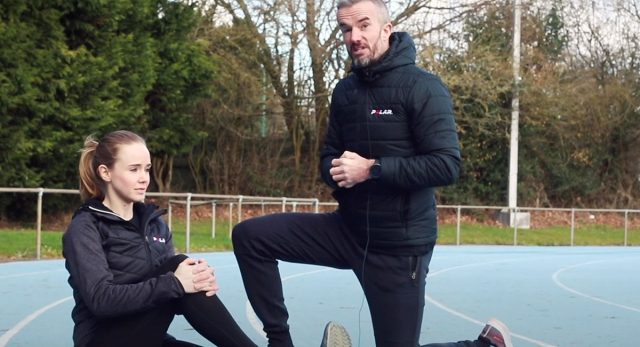Practicing mindfulness while running is all about being present during your runs and becoming more connected to your body. Mindful running can be beneficial in many ways – but not necessarily easy to do if you’re used to distractions, like music or checking your running metrics every two seconds.
So, how can runners who are used to focusing more on the destination than the journey get into the ‘zen’ zone?
To achieve mindfulness while running, use this plan to psychologically prep for your runs and put mindful running into practice to lower stress levels and improve your performance at the same time.
1. Leave the Gear at Home
While you don’t have to do this every time, to practice mindfulness while running you’ll want to have a minimalist approach for at least a few of your runs each week:
- Leave your headphones and music at home.
- If you’re in the habit of constantly looking at your running watch for pace, time, and cadence, cover your running watch with a long sleeve t-shirt and don’t look at your metrics until you upload them to your computer later in the day. (This way you can still track and analyze your running data without having to stress about it during your runs.)
- Turn off alerts and other sounds that might distract you from your run.
The goal of these runs is to be in tune with your body and how you feel instead of distracting yourself.
2. De-Stress Prior to Your Run
Before you head outdoors for your mindful run, you’ll need to learn to let go of all the other stresses in your life.
One way to do this is practice breathing exercises. Much like meditation, closing your eyes and focusing on deep belly breathing can be a great way to center yourself and prepare for the run ahead.
To practice, breathe in through the nose and focus on expanding your belly (diaphragm) with air instead of your chest. Let the air out slowly through your mouth and repeat for about five minutes.
Once you’re finished, you can do some light stretching if needed.
Before you start to run, try to think only about your goal for the workout:
- This doesn’t have to be anything to do with speed or distance. Instead, think about a goal for your mindfulness while running, like keeping your thoughts quiet, relaxing your shoulders more, or maintaining a better posture.
3. Start Slow
At the beginning of your mindful run, focus as much as you can on how your body is changing from the increased effort.
Start slow and pay attention to things like your breathing rate, your heart beat, and the rhythm of your arms and legs as they move. You may feel tight or sore, or your running form may seem off. All these things are okay. Don’t worry about fixing them or stress about making it better.
Instead, embrace how your body feels and simply observe it. You might be surprised how not worrying so much about how you feel can actually begin to feel more relaxed and looser as your run progresses.
4. Pay Attention to Your Surroundings
Part of the beauty of running outdoors is the ability to get in tune with nature.
Once you’ve eased into your run, spend some time noticing your surroundings. Focus on one thing at time, like the clouds in the sky or the fallen leaves on the ground.
If you’re in a more urban environment, notice the architecture of the buildings or the different colors in your surroundings. At night, notice the stars and the moon.
These things will help keep your mind quiet instead of giving attention to the stress in your life that can often pop up during a run such as a problem at work or chores that need to be done.
Keeping your focus on what’s around you will help you be in the moment, stay relaxed and enjoy your run.
5. Focus on Form
During the last portion of your mindful run, focus on your running form for a few minutes.
This will help your running become more efficient and allow your body to release tension easier.
Notice how straight or slumped your back is, how far forward ahead you’re looking, how your foot is striking the ground, and the effect gravity has on your body.
Ideally, you’ll want your body as upright as possible, with your head up, your shoulders back, and your arms moving front to back instead of sideways.
For your foot strike, listen to how your feet hit the ground:
- Think about being light on your feet and take quick, short steps.
- Imagine yourself gliding over the ground easily and pay attention to wear your foot hits the ground.
- Instead of being out in front of your body and slowing your momentum, bring the feet under the body and lift the heel towards the butt with the hamstring as it leaves the ground.
Remember, this doesn’t need to be a focus for the entire run, but is something you can do for a few minutes each time you head out.
6. Cool And Calm Down
Once you stop running, the recovery process can begin.
- Instead of ending your run at your car or house, walk the last hundred meters.
- Observe any areas of the body that feel tight or hurt along with the areas that feel more relaxed than when you started.
- Decide which areas of the body might need to be stretched or iced.
- Make time for taking care of those parts of the body that need attention.
After your heart rate and breathing have calmed, practice the same breathing exercises you tried before your run. If you’re short on time, you can do these in the shower or on the drive to work.
You only need five minutes or so to breath and reconnect with your body so it can head into a more relaxed state, which will help speed up your recovery for your next run.
If you liked this post, don’t forget to share so that others can find it, too.
Or give it a thumbs up!
I like this article
Please note that the information provided in the Polar Blog articles cannot replace individual advice from health professionals. Please consult your physician before starting a new fitness program.





